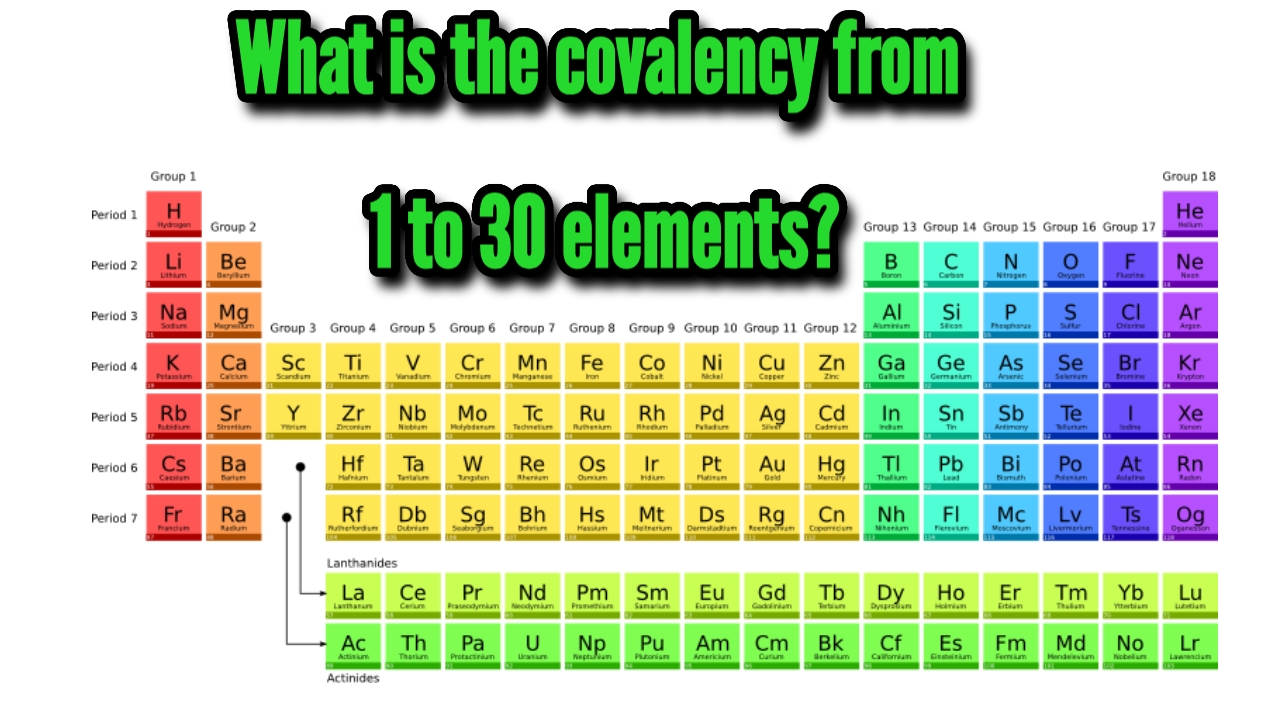What is the covalency from 1 to 30 elements?
The covalency of an element refers to the number of covalent bonds it can form with other atoms. Here’s the covalency for elements from 1 to 30
Definition
Covalency is the maximum number of single covalent bonds an atom can form.
The number of covalent bonds an atom can form by sharing electrons.
Determination
It depends on the number of unpaired valence electrons in an atom.
Some atoms can promote electrons from paired to unpaired states (excitation) to increase covalency (e.g., carbon forms 4 bonds by promoting an electron from the 2s to the 2p orbital).
Atoms may also expand their covalency using empty d-orbitals (e.g., sulfur in SF6)
- Hydrogen (H): 1
- Helium (He): 0 (inert, does not form covalent bonds)
- Lithium (Li): 1
- Beryllium (Be): 2
- Boron (B): 3 (can also exhibit 4 in some cases, e.g., BH₄⁻)
- Carbon (C): 4
- Nitrogen (N): 3 (can also exhibit 4, e.g., NH₄⁺)
- Oxygen (O): 2 (can also exhibit 1 or 3 in rare cases)
- Fluorine (F): 1
- Neon (Ne): 0 (inert)
- Sodium (Na): 1
- Magnesium (Mg): 2
- Aluminium (Al): 3
- Silicon (Si): 4
- Phosphorus (P): 3 or 5 (e.g., PCl₃ and PCl₅)
- Sulfur (S): 2, 4, or 6 (e.g., H₂S, SO₂, SF₆)
- Chlorine (Cl): 1 (can also exhibit 3, 5, or 7 in higher oxides/fluorides)
- Argon (Ar): 0 (inert)
- Potassium (K): 1
- Calcium (Ca): 2
- Scandium (Sc): 3
- Titanium (Ti): 4
- Vanadium (V): 5 (or lower in some compounds)
- Chromium (Cr): 6 (or lower, e.g., Cr³⁺)
- Manganese (Mn): 7 (e.g., KMnO₄), but commonly 2, 4, or 6
- Iron (Fe): 2 or 3
- Cobalt (Co): 2 or 3
- Nickel (Ni): 2
- Copper (Cu): 1 or 2
- Zinc (Zn): 2
How To Preparation and Standardization of 0.1N KMnO4 Solution?
Determination of Free Fatty Acids (FFA)
What is the name of the compound: NH3?
Notes:
- Covalency depends on the element’s valence electrons and bonding context.
- Transition metals (Sc-Zn) often exhibit variable covalency due to multiple oxidation states.
Covalency vs Valency
Both valency and covalency describe an atom’s ability to form bonds, but they differ in scope and application.
| Aspect | Valency | Covalency |
|---|---|---|
| Definition | The combining capacity of an atom (total bonds it can form, including ionic and covalent). | The number of covalent bonds an atom can form by sharing electrons. |
| Basis | Determined by electrons gained, lost, or shared to achieve stability (octet/duplet). | Depends on unpaired electrons available for sharing (may involve excitation or hybridization). |
| Scope | Includes ionic, covalent, and coordinate bonds. | Only covalent bonds (shared electrons). |
| Example | – Sodium (Na) has valency 1 (loses 1 electron). – Oxygen (O) has valency 2 (gains 2 electrons or shares 2). | – Carbon (C) has covalency 4 (forms 4 covalent bonds, e.g., in CH₄). – Nitrogen (N) has covalency 3 (e.g., in NH₃). |
| Variation | Fixed for many elements (e.g., Na is always +1). | Can vary due to excitation, hybridization, or d-orbital participation (e.g., P shows covalency 3 in PH₃ but 5 in PCl₅). |







Post Comment